December 7- 13, 2014: Issue 192
Portable Ice-Boxes and Coolers – How Many Claim This Invention as Theirs?
Portable Ice-Boxes and Coolers – How Many Claim This Invention as Theirs?
If you have a metal Esky from the 1960’s you’re thinking of trading in for a fandangled plastic one with a half life of two gazillion years, you may want to think again – metal ‘Esky’s’ from the 1960’s are currently offered for sale for $100.00 upwards. Yes!
More than a case of ‘one man’s trash is another’s treasure’ – these items are becoming quite popular. Remember those tartan Willow, and also made of metal, cold bricks you used to slip into the picnic basket to keep your curried egg sandwiches cold?; the asking price for these starts from $25 for collectors of 60’s and 70’s kitsch – possibly more than the original sale price.
While you’re sitting there humming ‘Everything old is new again’ under your breath while reading this our research into this now ‘collectible’ Australiana brought up a few questions which required a few answers.
Anytime you read anything about the ‘Esky’ part of what you reads claims that this was the first portable cooler ever invented.
Hmmm… Box + Ice + Handle to Carry with = Portable Ice Box. Did it really take the human race until the Summer of 1952 to put these things together – and take them to the beach, field or car?
No; ‘Esky’ in this reference must be a brand name coined by Malley’s (Australian) – but was this the first time ‘Esky’, derived from ‘Eskimo’, was used to describe something that chills or keeps things cool?
No, it was not. There were predecessors around the same time which were called ‘Ice-boxes’ one day and ‘refrigerators’ the next, depending where you looked. And these ‘refrigerators’ were so expensive that they could be paid off on terms:
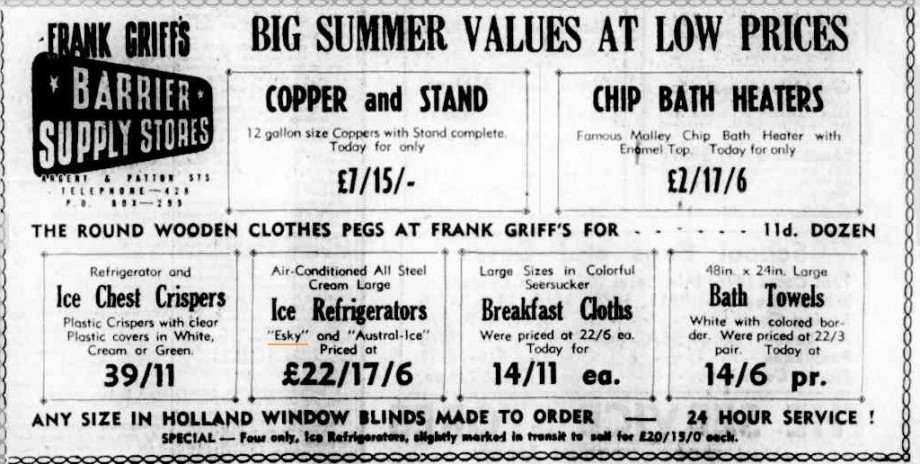
Air-Conditioned All Steel - Cream Large Ice Refrigerators 'Esky' and 'Austral-Ice' Priced at £22/17/6 Advertising. (1952, January 25).Barrier Daily Truth (Broken Hill, NSW : 1908; 1941 - 1954), p. 3. Retrieved from http://nla.gov.au/nla.news-article141206756
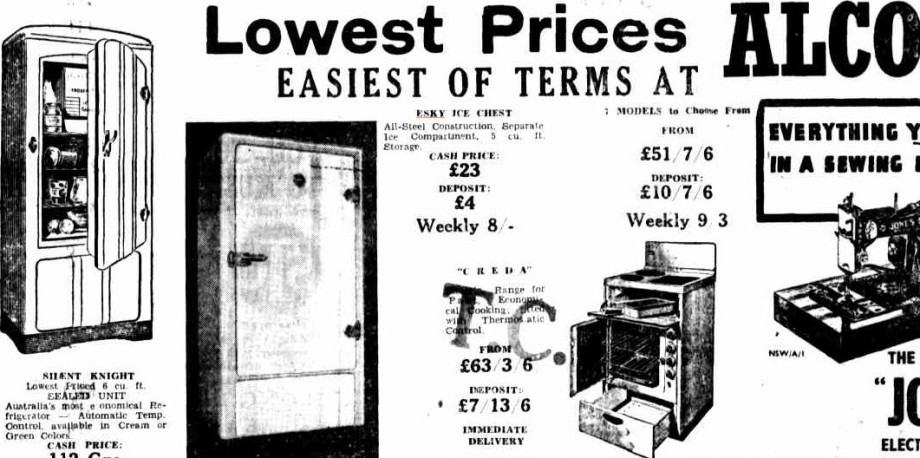
And later that year....
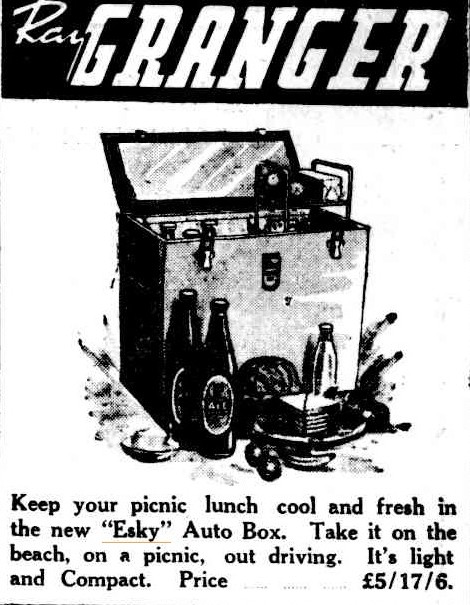
Keep your picnic lunch cool and fresh in the new "Esky" Auto Box. Take it on the beach, on a picnic, out driving. It's light and Compact. Price £5/17/6. Advertising. (1952, December 22). Northern Star (Lismore, NSW : 1876 - 1954), p. 4. Retrieved fromhttp://nla.gov.au/nla.news-article96458114
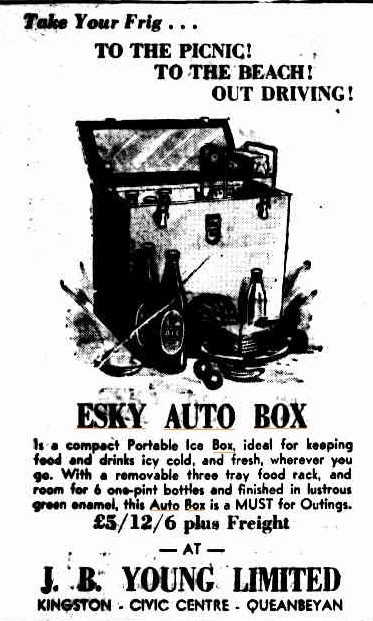
Take Your Frig . . .TO THE PICNIC! TO THE BEACH or OUT DRIVING! ESKY AUTO BOX is a compact Portable Ice Box, ideal for keeping food and drinks icy cold, and fresh, wherever you go. With a removable three tray food rack, androom for 6 one-pint bottles and finished in lustrousgreen enamel, this Auto Box is a MUST for Outings. £5/12/6 plus Freight! Display Advertising. (1953, December 8).The Canberra Times(ACT : 1926 - 1995), p. 6. Retrieved from http://nla.gov.au/nla.news-article2902571
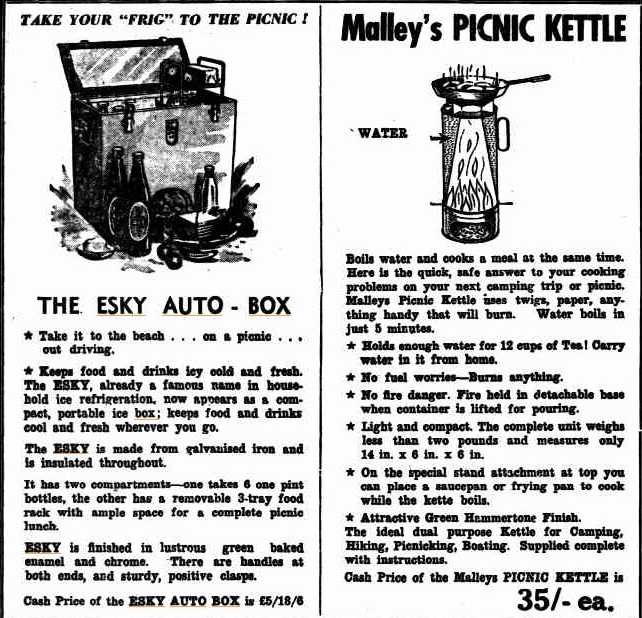
Esky Auto Box and Picnic Kettle: QLD: Advertising. (1954, August 20). Morning Bulletin(Rockhampton, Qld. : 1878 - 1954), p. 7. Retrieved from http://nla.gov.au/nla.news-article57336359
Many ascribe the invention of the ‘portable ice box’ to our post WWII fondness for the automobile picnic, and the original name for our 'Esky' seems to confirm this. Many sources state over 500, 000 'Esky Auti Box'es had been sold by 1954. Although camping holidays via a car were popular in the 1930’s, despite Australia being in the grip of The Depression, post-war determination to live and love life, brought out the best in us - creations to make life wonderful abounded.
Portable ice-boxes were around as early as the 1920’s, but lack of funds may have waylaid their mass production- and here too were more than one Australian claimant as the inventor of this practical cool receptacle. One of the earlier ones was Melbourne actor and theatre man of some note, Oscar Asche, and Tasmania the only place that took note:
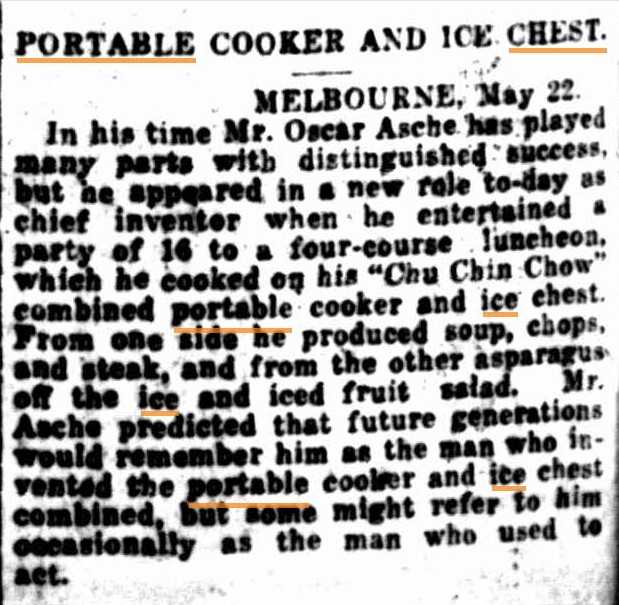 MR. ASCHE AS AN INVENTOR. (1924, May 23). The Mercury(Hobart, Tas. : 1860 - 1954), p. 4. Retrieved from http://nla.gov.au/nla.news-article23738056
MR. ASCHE AS AN INVENTOR. (1924, May 23). The Mercury(Hobart, Tas. : 1860 - 1954), p. 4. Retrieved from http://nla.gov.au/nla.news-article23738056
If you wade through a voluminous series, of very long interviews, you will find a few more anecdotes regarding this startling idea brought to fruition:
Actors and actresses, as a rule, take nothing between lunch and supper, but at all the hotelsit is impossible to get anything hot after we returned from the theatre. The inevitable cold chicken and ham always ready, present arms, as it were. And as we were doing a lot of motoring and cold food at that time of the year being somewhat chillsome, I invented a cooker, a portable cooker.
I got a cabinet-maker in Wellington to make one according to my design. It was very rough, but served its purpose. By its aid we were able to stew, fry, grill, bake, boil. Many a picnic did some of us have with it. When I returned to Sydney I improved on it, and took out patents for it all over the world. And I also sold the Australian and New Zealand rights.
On our return to Sydney I set to work on my patent cooker and perfected it. I also introduced into it an ice-chest in which ice would keep for three days. Before leaving Sydney I disposed of the Australian rights for £500 and 10 percent, of the sale price. Several people who made a hobby of camping out bought them and found them most useful. I gave several demonstrations. proving that it was wind and weather proof and perfectly safe. I took a car-load of friends up to the Blue Mountains, and when we returned on the Monday there was still ice in the chest. I took it out on the footboard of my car to Randwick race-course one race day, and cooked a lunch for eight people, not including myself. The cook was too busy to eat. I gave the lunchers oysters off the ice, tomato and lobster soup. Murray cod in Chablis, a mixed grill with peas and sauté potatoes, asparagus off the ice. And an omelette au Rhum. Some of them did not see the next race.
Motoring one day back to Melbourne we happened to pull up in -the most delightful grassy spot, with a clear running stream over pebbles and absolutely hidden from the road. Butwe were not the first campers there.Sitting on his heels, and smoking hispipe, a regular old sundowner(tramp), was feeding his fire with little bits of wood very gently. On the fire were two well-blackened billies. One was, of course, tea. and in the other were some mutton-bones for broth. His bluey was on the ground and by his side his little fox-terrier. How it brought back the old days, and Parkes! Two campers-out. But what a difference! He with his faithful hound, his pots and pans and blankets and his two logs to carry him, and I with my cooker and canteen and 40-50 Rolls-Royce. Which of us was the better off, the happier? He, for a thousand.
A Camp Meal - Whilst Gross was preparing lunch I had a chat with him. He joined us In a cocktail. He was an educated man.
"You're Oscar Asehe," he said. I admitted It. "I was just reading about you in the paper. Here's your photograph." and he showed me a Melbourne paper, a fortnight old, announcing the coming season. He had tramped from Melbourne..... REMINISCENCES OF STAGE AND SPORT: OSCAR ASCHE, COOK. (1930, March 13). Table Talk (Melbourne, Vic. : 1885 - 1939), p. 54. Retrieved fromhttp://nla.gov.au/nla.news-article147566351
Was this man he sold his ‘invention’ to?;
PORTABLE ICE CHEST.
The auto portable Ice chest, an invention of Mr. Vic Stead, of Lidcombe, should be found useful by tourists. Actually, it is a dual purpose device, being a strongly-made perfectly Insulated Ice chest, fastened to the rear carrier of a car by wing nuts, from which the Interior fittings may, If necessary, be removed with very little effort, converting it into an ordinary luggage container. It has a compartment for a large block of ice, the water draining out on the road, on one side of this are three containers for meat, butter, and other food, and on the other side, a rack In which bottles may be carried in safety. The trunk or chest may be finished either in fabrikold or painted, and the price is moderate. NOTES. (1929, August 27). The Sydney Morning Herald (NSW : 1842 - 1954), p. 6. Retrieved fromhttp://nla.gov.au/nla.news-article165786
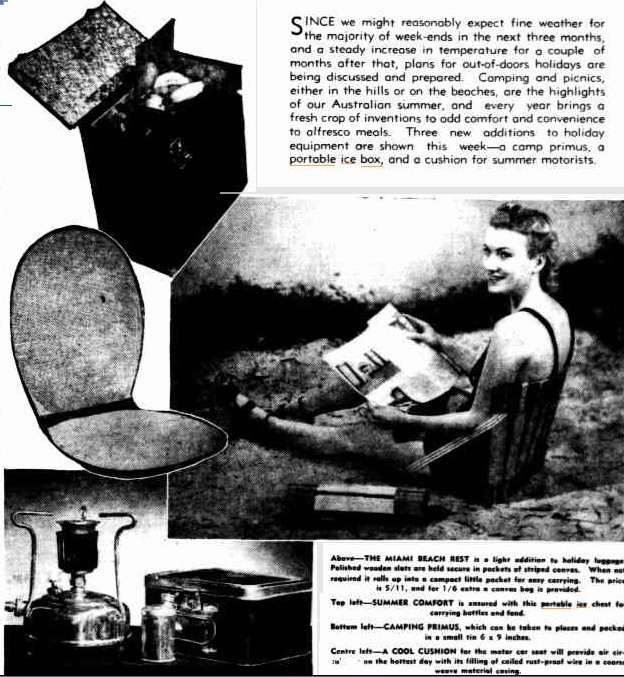 New Invention. (1929, July 18). The Cumberland Argus and Fruitgrowers Advocate (Parramatta, NSW : 1888 - 1950), p. 3. Retrieved from http://nla.gov.au/nla.news-article104714085
New Invention. (1929, July 18). The Cumberland Argus and Fruitgrowers Advocate (Parramatta, NSW : 1888 - 1950), p. 3. Retrieved from http://nla.gov.au/nla.news-article104714085
All of a sudden the idea spread, providing numerous versions: A version made from recycled products – made possible by a practical of Depression inventor: ICE CHEST MAKING. (1930, November 22). Cairns Post (Qld. : 1909 - 1954), p. 7. Retrieved fromhttp://nla.gov.au/nla.news-article41114568
Or at right from 1938:
Even Post-war practicality when so much was still so scarce:
'Hot Boxes' As Ice Chests
Able to be converted to portable ice-chests, ex-Army 'hot boxes’ sold quickly at a Commonwealth Disposals Commission auction sale in Perth today. - -The 'hot boxes' were used in the Army for keeping food hot in transit from cookhouses to outlying troops. Well insulated, they were filled with hot water and then dixies containing the food were placed in the water. Many units used 'hot boxes' filled with ice, when it was available, tocool the men's beer issue. Hot boxes' have handles for ease in carrying. Camouflage nets, washing tubs and buckets, tables, beds, cooking gear were also scheduled for sale at today's auction Sale was held at 367 Murray Street. Next auction of miscellaneous goo ds at this store will be on March 15. "Hot Boxes" As Ice Chests. (1946, March 8). The Daily News(Perth, WA : 1882 - 1950), p. 10 Edition: CITY FINAL. Retrieved from http://nla.gov.au/nla.news-article78250262
The ice thickens, or hardens! Examination of the words shows that it is the type of construction that Malley’s invented, theirs being ‘TheEsky'; was created by Malley's, a Sydney refrigeration business. The construction is made up of two layers: polypropylene on the outer shell, with a polyurethaneinner layer. This makes it lightweight and portable with excellent insulation. The Esky originally had a steel outside shell.’
While our cousin Americans claim: ‘The portable ice chest was invented by Richard C. Laramy of Joliet, Illinois. On February 24, 1951, Laramy filed an application with the United States Patent Office for a portable ice chest (Serial No. 212,573). The patent (#2,663,157) was issued December 22, 1953.
The Coleman Company popularized the cooler with its initial offering of a galvanized cooler in 1954. Three years later, Coleman developed a process to make a plastic liner for coolers and jugs.'
The dates don’t match… or Mr. Malley's men were traipsing through the US of A, pinching ideas from others while they were trying to patent them.... and so we refer back to our Ice + Box + Handle =….
And peer a little further in:
Before the invention of the refrigerator, icehouses were used to provide cool storage for most of the year. Placed near freshwater lakes or packed with snow and ice during the winter, they were once very common. Natural means are still used to cool foods today. On mountainsides, runoff from melting snow is a convenient way to cool drinks, and during the winter one can keep milk fresh much longer just by keeping it outdoors. The word "refrigeratory" was used as early at least as the 17th century
The history of artificial refrigeration began when Scottish professor William Cullen designed a small refrigerating machine in 1755. Cullen used a pump to create a partial vacuum over a container of diethyl ether, which then boiled, absorbing heat from the surrounding air. The experiment even created a small amount of ice, but had no practical application at that time.
In 1805, American inventor Oliver Evans described a closed vapor-compression refrigeration cycle for the production of ice by ether under vacuum. In 1820, the British scientist Michael Faraday liquefied ammonia and other gases by using high pressures and low temperatures, and in 1834, an American expatriate to Great Britain, Jacob Perkins, built the first working vapor-compression refrigeration system in the world. It was a closed-cycle device that could operate continuously.[4] A similar attempt was made in 1842, by American physician, John Gorrie, who built a working prototype, but it was a commercial failure. American engineer Alexander Twining took out a British patent in 1850 for a vapour compression system that used ether.
The first practical vapor compression refrigeration system was built by James Harrison, a British journalist who had emigrated to Australia. His 1856 patent was for a vapour compression system using ether, alcohol or ammonia. He built a mechanical ice-making machine in 1851 on the banks of the Barwon River at Rocky Point in Geelong, Victoria, and his first commercial ice-making machine followed in 1854. Harrison also introduced commercial vapour-compression refrigeration to breweries and meat packing houses, and by 1861, a dozen of his systems were in operation. Refrigerator. (2014, December 3). In Wikipedia, The Free Encyclopedia. Retrieved from http://en.wikipedia.org/w/index.php?title=Refrigerator&oldid=636515239
Ahh, yes; back to Australia again, where we love old beer and wine. The spreading of original coolness developed thus:
THE NARROGIN ICE WORKS - A FINE LOCAL ENTERPRISE
Of the local industries in Narrogin none deserve more support from the residents than the Narogin Ice Works whose product is such a valuable asset in the summer months, besides adding comfort and enjoyment in various directions and when uses of ice are thoroughly appreciated it would not be surprising to see almost every house numbering amongst its necessary furniture a family ice chest, the use of which in the hot weather would be the means of preserving much food as well as ensuring it appearing 011 the table in a more appetising form than would be otherwise possible.
The factory was established by Williams & Co., and after a series of vicissitudes, misfortunes and struggles was first in operation during the present summer, and under the management of Mr. Stott, has produced a very fine article. The plant consists of a 25 h.p. portable Robey engine and boiler, 6 ton compressor, ammonia cooler and condenser, the water being lifted to a height of 36 feet and allowed to fall down the tower which reduces the temperature some 15 percent. The water is afterwards conveyed to the ice tank, the capacity of which is 40 1 cwt. blocks, equal to2*tons. The factory is further equipped with a cool chamber, 12 by 14feet, in which meat, milk, fruit and other food commodities can be kept ina cool state without freezing, an ice storage room, and a new addition in the form of a complete butcher’s small goods plant, where a variety of these comestibles are manufactured. A staff of four, in addition to the manager (Mr. -Stott) are Kept fully employed during the summer months.
Trade relations have been opened out with various sister towns; find supplies of ice are being sent as far as Katanning, Bruce Rock, Naremheen'
Brookton and Williams. The. Great advantage to consumers of the Narrogin product is the saving of freight which is nearly 50 per cent, cheaper than from Perth and the slight loss that takes place in reduced weight as the ice is taken direct from the ice chamber to the train. From Perth, we understand that 50 per cent, is a usual thing, while.10 per cent, covers the reduction in weight from Narrogin to any of the destinations mentioned above.
At the present time, as the season is approaching its end, the management are .inviting; application for cool storage space for apples and district orchardists would do well in testing this means of increasing their returns as when the glut becomes exhausted, their fruit can be marketed -on much more advantageous terms and in many cases what are now a dead loss canbe altered into profit. We trust that the cool storage will be taken advantage of as by this means the factory will be enabled to run during the winter months. THE NARROGIN ICE WORKS. (1923, March 9). Great Southern Leader (Pingelly, WA : 1907 - 1934), p. 5. Retrieved from http://nla.gov.au/nla.news-article157089324
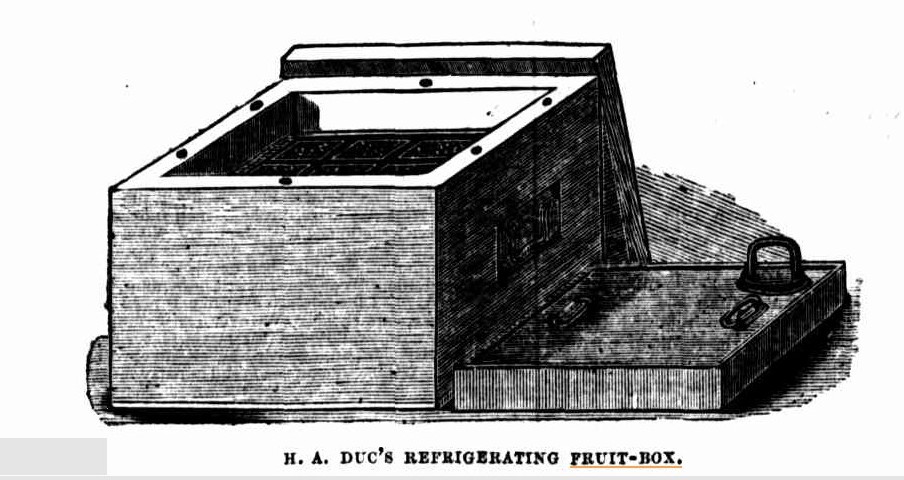
Extras:
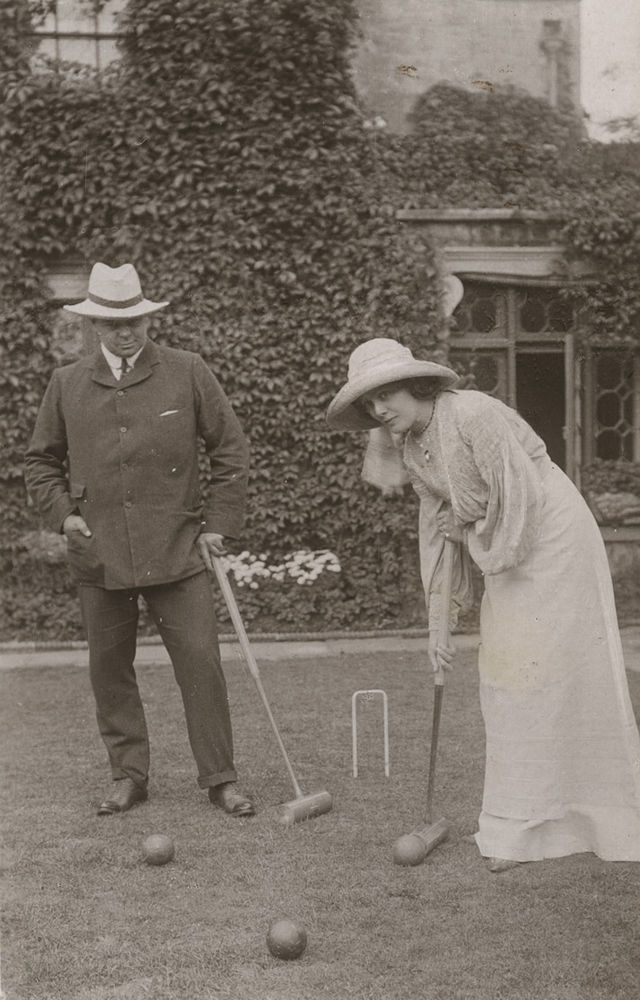 John Stange(r) Heiss Oscar Asche (26 January 1871 – 23 March 1936), better known as Oscar Asche, was an Australian actor, director and writer, best known for having written, directed, and acted in the record-breaking musical Chu Chin Chow, both on stage and film, and for acting in, directing, or producing many Shakespeare plays and successful musicals.[1]
John Stange(r) Heiss Oscar Asche (26 January 1871 – 23 March 1936), better known as Oscar Asche, was an Australian actor, director and writer, best known for having written, directed, and acted in the record-breaking musical Chu Chin Chow, both on stage and film, and for acting in, directing, or producing many Shakespeare plays and successful musicals.[1]
After studying acting in Norway and London, Asche made his London stage debut in 1893 and soon joined the F R Benson Company, where he remained for eight years, playing more than a hundred roles including important Shakespearean parts. He married the actress Lily Brayton in 1898, and the two were often paired onstage for many years. He played Maldonado in Arthur Wing Pinero's Iris in the West End in 1901, his first important part in modern comedy. He repeated the role on Broadway the following year, and then joined Herbert Beerbohm Tree's theatre company in London in 1902, playing more Shakespearean roles over the next few years.
Asche and his wife became managers of the Adelphi Theatre in 1904 and His Majesty's Theatre in 1907; he made his first tour of Australia in 1909–10, and was much moved by his reception in his native land. In 1911 Edward Knoblockwrote the play Kismet for him; Asche revised and shortened it, and the production enjoyed great success in London and on tour with Asche in the leading role of Hajj.
Asche most famously wrote and produced Chu Chin Chow, starring himself and his wife, which ran for an unprecedented 2,238 performances, from 31 August 1916 to 22 July 1921. During the run, among other projects, he directed the hit London production of The Maid of the Mountains. From 1922 to 1924 he toured in Australia with the J C Williamsoncompany. As a result of his high-spending lifestyle, he was declared bankrupt in 1926. Though his success as a producer waned, he continued to direct and act, including in several films, until the mid-1930s. Oscar Asche. (2014, October 25). In Wikipedia, The Free Encyclopedia. Retrieved from http://en.wikipedia.org/w/index.php?title=Oscar_Asche&oldid=631116640
Iceboxes had hollow walls that were lined with tin or zinc and packed with various insulating materials such as cork, sawdust, straw or seaweed. A large block of ice was held in a tray or compartment near the top of the box. Cold air circulated down and around storage compartments in the lower section. Some finer models had spigots for draining ice water from a catch pan or holding tank. In cheaper models a drip pan was placed under the box and had to be emptied at least daily. The user had to replenish the melted ice, normally by obtaining new ice from an iceman.
Commonly iceboxes were made of wood, most probably for ease of construction, insulation, and aesthetics: many were handsome pieces of furniture. Icebox. (2014, November 21). In Wikipedia, The Free Encyclopedia. Retrieved from http://en.wikipedia.org/w/index.php?title=Icebox&oldid=634776154
Peter Dawson - The Cobbler's Song from Chu Chin Chow
Peter Dawson sings The Cobbler's Song from Chu Chin Chow by Oscar Asche and Frederic Norton. (video uploader: I have the piano score for this which was given to me with the words that it was once owned by a Pianist that accompanied Dawson. Like to think Dawson may have held the score at one time!)
by A J Guesdon, 2014.